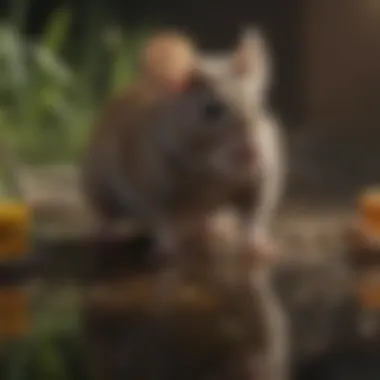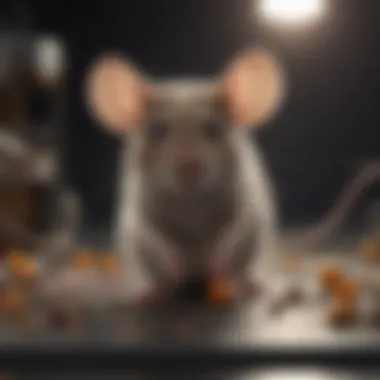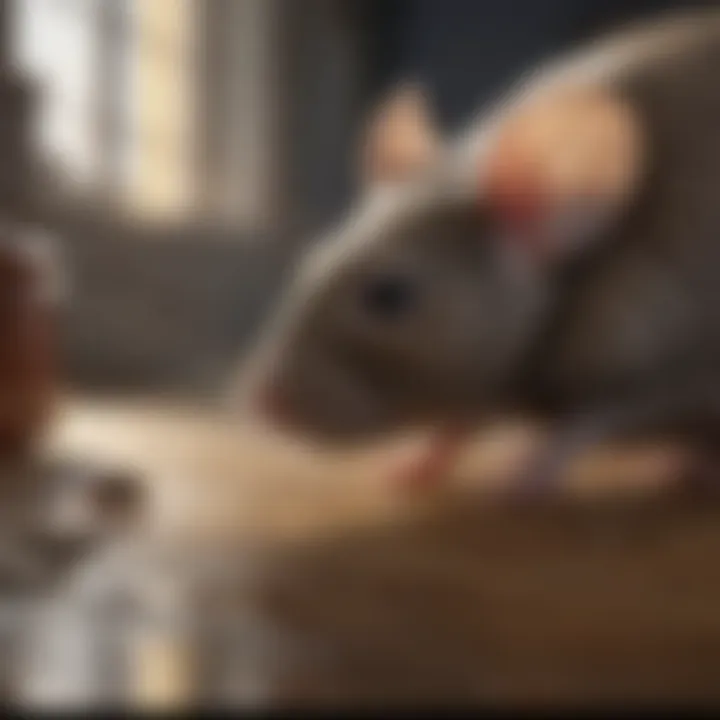Understanding Mice Behavior Towards Poison


Intro
Mice are often perceived as mere pests, yet their behavior towards hazardous substances like poison reflects a remarkable depth of intelligence and adaptability. This article investigates the fundamental aspects of how mice detect and avoid toxic agents. By examining their biological attributes and cognitive processes, we aim to shed light on the complexities of rodent behavior and the implications for pest management strategies. Understanding what influences mice decisions can lead to more effective control methods for homeowners and pest control professionals alike.
Understanding the Pest
Identification
Mice belong to the family Muridae and can be identified by several distinguishing features. Common species such as the house mouse (Mus musculus) are typically grayish in color. They have pointed snouts and large ears. Size usually ranges from 2.5 to 4 inches in body length, excluding the tail. Their small size enables them to enter various spaces, making them hard to track.
Life Cycle
The life cycle of mice includes several stages:
- Gestation: Female mice can reproduce at around six weeks old, with a gestation period of about 19 to 21 days.
- Pups: Newborn mice, or pups, are born hairless and blind.
- Maturity: By three to four weeks, they become weaned and start to explore their environment.
- Life Span: Under optimal conditions, mice can live for up to two years, contributing to their rapid population growth.
Behavioral Patterns
Mice display intelligent behavior. They learn from experiences, which helps them avoid dangers, including poison. Research shows that when they encounter a toxic substance, they can make connections between their biological responses and the environment. This adaptability aids in their survival.
Pest Prevention Strategies
Environment Modification
One effective approach to prevent mice infestations is modifying their environment. Homeowners should consider the following:
- Seal Entry Points: Identify and seal any holes or cracks in walls, foundations, or around windows.
- Eliminate Food Sources: Store food in airtight containers and clean up crumbs that attract mice.
- Reduce Clutter: Keeps areas tidy, as clutter can provide hiding spots for mice.
Physical Barriers
Implementing physical barriers can enhance effectiveness:
- Use steel wool to fill openings, as mice are less likely to gnaw through it.
- Install door sweeps to block access through gaps.
- Mesh screens or wire mesh can be used on vents or larger openings.
Control Methods
Chemical Control
Chemical methods often involve the use of rodenticides. However, it's essential to understand their limitations and ensure proper application:
- Mice can develop resistance to certain poisons, making them less effective over time.
- Using bait stations that secure the poison can limit exposure to non-target animals and children.
Biological Control
An alternative is biological pest control, which employs natural predators such as cats or snakes. This approach leverages the ecological balance to manage mouse populations effectively.
"Understanding the behaviors and adaptability of mice provides critical insights for homeowners to develop better pest management strategies."
Ultimately, by recognizing the intelligence behind mice behaviors, one can craft more precise and effective approaches for pest control. This not only minimizes the impact on the environment but also ensures the safety and health of human inhabitants.
Prologue to Rodent Behavior
Understanding the behavior of rodents, particularly mice, is crucial for anyone involved in pest management or those simply looking to protect their homes. Mice display complex behaviors that are not only instinctual but also learned and influenced by their environment. This section will explore how these behaviors impact their interactions with poisons and traps that are commonly used to control their populations.
The avoidance of poison by mice is not merely a simple reaction. It involves a range of physiological and cognitive processes. This is why knowing mouse behavior can aid in developing more effective pest control strategies. By digging into how mice perceive their surroundings and respond to threats, we bring to light methods that can improve pest management practices in urban and rural settings alike.
General overview of mice species
Mice belong to numerous species, but the most common in residential areas is the house mouse, Mus musculus. Mice are small rodents, typically measuring around 6 to 10 inches in length including their tails. They display considerable adaptability to various environments, which aids in their survival.
House mice prefer areas close to humans for food and shelter. They have a high reproductive rate, making them a persistent issue in households. Understanding the biological and behavioral traits of house mice helps in forming an effective response to their presence. Their nocturnal nature and tendency to prioritize safety when foraging make them particularly challenging to deal with.
Mice are social animals that often live in groups, which can influence their behavior regarding food and danger. Their social structure allows them to communicate risks effectively among themselves, further complicating pest control efforts. Thus, knowing these creatures is essential for a thorough understanding of their interactions with toxic substances.


Importance of understanding mouse behavior
The study of mouse behavior is not just academic; it has practical implications in pest control and public health. Understanding why and how mice avoid poison can lead to better management strategies that not only reduce their populations but also minimize harm to non-target species.
Mice have evolved certain defenses against toxins. They often exhibit innate aversions to bitter-tasting substances, which typically indicate potential danger. Additionally, past experiences with poison can lead to learned aversions, making them even more wary of anything that resembles their previous encounters with poison.
Moreover, the habits developed by mice living in specific environments can alter their feeding behavior. Unstable food sources can lead them to test new foods, but consistent access to safe food will make them avoid risky options, such as pest control treatments.
To summarize, a deeper understanding of mouse behavior allows homeowners and pest control experts to devise strategies that not only address the immediate threat of these rodents but also account for their complex behavior, which is essential in developing long-lasting solutions in rodent management.
The Biology of Mice
Understanding the biology of mice is crucial in comprehending how they interact with their environment, particularly regarding their avoidance of poison. Mice possess a unique set of physiological and cognitive traits that equip them to navigate challenges in their surroundings. By studying these aspects, we can gain invaluable insights into their behavior and adapt our pest management strategies effectively. The survival of a species depends on its ability to respond to threats, and mice exemplify this in their reaction to toxic substances.
Physiological adaptations
Mice have evolved various physiological adaptations that enable them to survive in diverse ecosystems. Their keen sense of smell plays a central role in detecting danger. Mice can identify a wide range of scents, including the chemical signatures of toxins. This ability likely evolved as a survival mechanism, allowing them to avoid foods that may be harmful.
Additionally, mice have a highly developed gastrointestinal system. They can tolerate certain poisonous substances in small amounts, which might explain why they sometimes consume bait before learning to avoid it. This resilience demonstrates that mice can adapt to their environment, making them formidable opponents in pest control.
Mice are also small and agile, allowing them to escape quickly from perceived threats. Their reproductive strategy, involving the production of large litters, further emphasizes their survival instincts. When faced with dangerous conditions, populations can quickly rebound despite control measures. These physiological attributes create significant challenges for controlling rodent populations effectively.
Cognitive capabilities
The cognitive abilities of mice are equally remarkable. Research shows that mice can learn from their experiences in ways that directly impact their behavior toward poison. For example, studies have indicated that mice can associate specific locations or food types with negative experiences. When a mouse consumes a poisonous substance and becomes ill, it can remember that experience. As a result, they may avoid that food or area in the future.
Moreover, social learning among mice contributes to their intelligence. They observe and mimic the behaviors of other mice. If one member of a group has a negative experience with a poison, others may learn to avoid it as well, even without direct exposure. This adaptability makes understanding social dynamics among rodent populations essential for developing effective pest management strategies.
In summary, the biology of mice involves complex physiological and cognitive traits that facilitate their survival, particularly in response to toxic threats. By recognizing these adaptations, we can enhance our approach to pest control and develop solutions that consider the nuances of rodent behavior.
Types of Poison Used in Rodent Control
Understanding the various types of poison used in rodent control is crucial in both comprehending how they function and the ways in which mice manage to avoid them. Each type of poison acts differently and has distinct characteristics that impact both effectiveness and the behavior of the rodents involved. By knowing these specifics, homeowners can make informed decisions about pest management strategies while considering the ecological balance.
Anticoagulants
Anticoagulants are among the most commonly used poisons in rodent control. Their primary action involves disrupting the blood's ability to clot, leading to internal bleeding over time. Some well-known anticoagulant compounds include bromadiolone and brodifacoum. These compounds can be effective, as they require repeated ingestion to exert their lethal effect, allowing for a gradual decline in rodent populations.
However, mice can become wary of anticoagulants if they experience non-lethal intake. Mice that consume a sub-lethal dose may associate the bait with an unpleasant experience. This conditioning can lead to avoidance of these poisons in future encounters.
Neurotoxins
Neurotoxins represent another category of rodent poison, often acting much faster than anticoagulants. These substances interfere with the normal functioning of the nervous system, resulting in paralysis or death within hours of ingestion. Notable examples include bromethalin and warfarin, both of which disrupt synaptic transmission.
Mice show a strong instinctual aversion to such substances, especially if they have previous exposure to them. The rapid onset of symptoms might encourage rodents to avoid neurotoxin baits altogether, as they can quickly associate the poison with immediate danger.
Gastrointestinal Toxins
Gastrointestinal toxins are designed to cause severe abdominal distress or lethal disruption to the digestive system of rodents. This category can include natural toxins such as those found in certain plants or synthesized chemicals. An example is Zinc Phosphide, which releases phosphine gas when ingested, producing distressing effects that lead to a quick demise.
While these types of poison can prove successful in controlling rodent populations, they can also lead to learned avoidance behaviors. If mice encounter gastrointestinal discomfort after consuming a bait, future consumption becomes less likely. They may educate other members within their social groups, compounding the effect of avoidance within the local population.
"Understanding the types of poison helps in selecting the most appropriate options for controlling rodent populations."
Why Mice Avoid Poison
Understanding why mice avoid poison is critical to formulating effective pest control strategies. Mice exhibit complex behaviors that stem from their biology and social structures. These instincts play a pivotal role in their survival. Being aware of these factors helps homeowners and pest control professionals design better methods to manage rodent populations.
Instinctual aversion to toxins
Mice possess a strong instinctual aversion to certain substances that they identify as toxic. This instinct is largely rooted in their evolutionary history. Mice have developed sensors that detect bitter flavors, which are commonly associated with poisonous plants or chemicals. When a mouse consumes a bitter-tasting food, it often leads to a positive correlation with negative outcomes, such as sickness. This creates a learned behavior where the mouse avoids future encounters with similar tastes.
Studies suggest that this aversion might also be connected to their sensory systems, particularly in detecting dangerous foods. Their olfactory sense plays a crucial role in identifying dangerous substances through smell. This aversion is not merely a product of experience; it is hardwired, allowing for quick adaptation in varied environments.


Previous exposure and learned behavior
Previous exposure to a specific toxin greatly influences a mouse's future choices. If a mouse ingests a toxin and experiences negative effects, it will likely remember this event. This memory enables mice to avoid that specific poison in the future, showcasing their capacity for learning and memory.
These learned behaviors can be so strong that they impact the entire population. For instance, if one mouse learns to avoid a particular poison, it can communicate this knowledge with others in its group. This phenomenon illustrates how individual experiences accumulate into collective knowledge, which enhances survival rates among rodents. This learned avoidance can present significant challenges for pest control efforts, as once a population learns to evade certain poisons, those methods become ineffective.
Social learning among rodent groups
Mice are highly social creatures, often living in groups. This social structure enables the exchange of information. Research has shown that mice can observe others and learn from their experiences. If one mouse discovers that a particular food source is toxic and becomes ill, others in the group may witness this event. Consequently, they may instinctively avoid that food source as well.
This type of social learning is crucial for survival, as it allows mice to adapt quickly to changing environments. The implications for pest control efforts are substantial. Controlling a population of mice requires more than targeting individuals; it involves understanding and addressing the communal behaviors that contribute to their collective knowledge.
Environmental Factors Influencing Poison Avoidance
Understanding the environmental factors that influence how mice avoid poison is crucial for both effective pest management and the broader understanding of rodent behavior. Mice do not operate solely based on instinctive reactions; they also respond to their surroundings in complex ways. The following sections will examine the significant elements affecting their avoidance of toxic substances, emphasizing how these factors interrelate.
Availability of Food Sources
Food availability plays a vital role in determining mice behavior regarding poisons. When nutrient-rich food sources are abundant, mice are less likely to approach poison bait. They tend to prioritize familiar and safe food options over unfamiliar or toxic ones. Consequently, if a location presents an adequate supply of natural food, such as seeds or insects, the likelihood of mice consuming a toxic substance greatly diminishes.
Furthermore, if the bait offers similar or lesser nutritional incentive compared to natural food items, mice will instinctively choose to forage for the safer option. This aversion can lead to decreased effectiveness of commonly used poisons. People managing pest control should consider strategies that restrict food availability or utilize food sources that are less appealing to mice.
Presence of Other Animals
The presence of other animals can greatly influence the behavior of mice concerning poison. Predators or competing species can alter foraging dynamics. For instance, if a mouse sees another animal displaying signs of distress after consuming a substance, it may quickly learn to avoid that food source. This is commonly seen as a part of their natural instinct to preserve their survival.
Additionally, competition with other rodents can impact their behavior. If other rodents are in the vicinity, the likelihood of mice encountering poison may change. They might ignore poison bait if they perceive risk from rivals or larger predatory threats around. Thus, assessing the environment for other species is crucial when selecting pest control methods.
Habitat Conditions
Habitat conditions also significantly influence how mice react to poison. Factors such as temperature, moisture, and shelter availability can dictate whether mice will engage with poisons or seek alternatives. Mice prefer environments that offer easy accessibility to places they can hide from threats.
If an area is overly moist or has extreme temperatures, mice may retreat to less inviting spaces, deterring them from approaching bait stations. Conversely, if the habitat is stable, with optimal shelter, mice are more likely to venture out and assess food offerings, including poison. Pest control methods should therefore take such habitat qualities into account to improve effectiveness and safety.
"Understanding mice behavior in relation to their environment offers practical insights into successful rodent control methods and helps in minimizing the risks of toxic exposure to non-target wildlife and pets."
In summary, environmental influences—ranging from food availability to the presence of other animals and specific habitat conditions—play vital roles in how mice respond to poisons. Knowledge of these factors allows for improved pest management strategies and helps to foster a deeper understanding of rodent behavior.
Implications for Pest Management
Understanding how mice avoid poison carries critical implications for pest management strategies. The behavior of mice in response to toxins is not simply random. It reflects an advanced level of intelligence and adaptability. Addressing this can significantly enhance the efficacy of control measures undertaken in both residential and commercial settings.
Challenges faced in rodent control
The foremost challenge in rodent control is the inherent instinct mice possess to evade toxic substances. Over generations, these creatures have developed a heightened sensitivity toward potential dangers, particularly chemicals that could harm them. This aversion complicates the traditional methods of baiting with poisons such as anticoagulants and neurotoxins. For example, mice that have encountered these toxins previously can develop a learned behavior that enables them to recognize and resist them in the future. This creates a cycle of poison resistance, leading pest control professionals to repeatedly change substances or methods in response to the problem.
Moreover, the presence of environmental factors also poses challenges. For instance, if there are abundant food sources outside of traps or if other animals, such as cats or birds, are around, mice may choose to avoid areas where they might encounter the poison. This adaptability showcases their intelligence and poses additional complications in effectively managing rodent populations.
Alternative methods to deter rodents
In light of the challenges associated with traditional poison-based methods, there is an increasing focus on alternative strategies to deter rodents. One effective approach involves habitat modification. This might include sealing entry points into homes, reducing clutter, and ensuring that food sources are stored securely. By taking these precautions, homeowners can make their environments less inviting to rodents.
Additionally, employing traps is another alternative. Snap traps or live traps can be effective and do not rely on the chemical approach that mice actively avoid. Traps can be deployed in strategic locations, ensuring that the chances of capturing rodents are maximized without the complications of poison avoidance.
Also, using natural deterrents like peppermint oil or ultrasonic devices can discourage mice from nesting in particular areas. These methods resonate better with eco-conscious households.
Eco-friendly approaches to rodent management
Emphasizing eco-friendly approaches is becoming increasingly relevant in pest management discourse. As public awareness grows regarding the adverse effects of chemical pesticides on ecosystems, interest has surged in sustainable practices.
A key eco-friendly method is the use of biological control. This involves introducing predators or parasites that specifically target mice, thereby naturally reducing their populations. In addition, integrating methods such as habitat restoration can enhance the natural predation afforded by the ecosystem. This balanced approach reduces reliance on chemical means, making pest management sustainable in the long run.
Homeowners can also consider preventive measures grounded in sustainability. By maintaining cleanliness in and around the home, sealing potential entry points, and managing waste effectively, mice can be deterred from entering residential spaces without the need for toxic substances.


Control of rodent populations can be achieved with thoughtfulness toward the environment, focusing on natural deterrents and practices that foster long-term solutions.
Research and Studies on Rodent Behavior
Understanding how mice respond to various stimuli, including poison, plays an essential role in developing effective pest control strategies. Research and studies into rodent behavior reveal not only how mice avoid these substances but also the underlying mechanisms behind their decision-making processes. By examining these behaviors, researchers can identify specific patterns and develop better control methods.
This topic also has direct implications for homeowners facing rodent infestations. The insights gained from studies can drive the development of more humane and eco-friendly approaches to pest management, leading to better outcomes for both humans and rodents.
Key findings in behavioral studies
Recent studies have highlighted several key findings regarding rodent behavior in the context of poison avoidance. Research indicates that genetically, some mouse species may have an innate ability to recognize potential toxins. This instinctual behavior helps them identify and avoid dangerous substances in their environment.
Additionally, previous exposure to certain toxins can condition mice to recognize similar harmful agents in the future. Behavioral experiments show that if a mouse has encountered a toxic food source before, it is more likely to avoid foods that have similar characteristics, even if those foods are not poisonous.
Social learning also plays a pivotal role. Mice often observe the behaviors of other mice in their group. If one mouse experiences negative effects from a certain food, it is more likely that others in the group will also avoid that food. This enhances their overall survival and drives the evolution of arming behavior among rodent populations.
Technological advancements in behavioral research
Technological advancements have significantly improved our understanding of rodent behavior. New tools like tracking devices and imaging technologies allow researchers to observe the interactions of mice in more natural settings. For example, high-resolution cameras can capture detailed movements and decisions made by mice when choosing food sources.
Additionally, the emergence of genetic engineering has opened new avenues for research. Scientists can now alter specific genes in model organisms to better understand the biological basis of behavior. This can show how certain genetic factors influence a rodent's ability to perceive and react to poisonous substances.
Lastly, computational modeling plays a crucial role in simulating rodent behavior. By creating complex algorithms, researchers can predict how populations will respond to different pest control methods. This predictive capability makes it easier to develop strategies that are more efficient, reducing unnecessary harm to both the target species and the environment.
"Understanding rodent behavior enables better pest control and promotes more humane methods in dealing with rodent populations."
As we accumulate insights from behavioral studies, we can begin to formulate more effective management strategies. This knowledge empowers homeowners and pest control professionals alike, leading to enhanced practices that acknowledge the intelligence and adaptability of mice.
Case Studies of Mice and Poison Avoidance
Understanding the specific case studies related to mice and their avoidance of poison is crucial for multiple reasons. Firstly, these case studies provide real-world insights into the effectiveness of various rodenticides and alternative strategies for pest management. By examining these instances, researchers and pest control professionals can identify patterns in mouse behavior that reveal their intelligence and adaptability. Such knowledge not only informs future approaches to rodent management but also helps to re-evaluate current practices that may be ineffective.
Case studies can illustrate the failures of traditional poisons, highlighting why certain methods may not work as intended. They also shed light on successful alternatives that engage the mice's learned behaviors rather than relying solely on toxicity. Overall, the implications are significant for both pest control practitioners and homeowners seeking to address rodent issues in a humane and effective manner.
Real-world examples of failed rodenticides
There are numerous documented instances where the use of rodenticides has not only proven ineffective but also backfired. One such example is the widespread application of the anticoagulants like Brodifacoum and Bromadiolone, which at first appeared to be effective. However, studies showed that mice that survived initial exposures developed an aversion to the bait. The constant availability of these poins led to an increase in bait shyness among rodent populations, which meant that the mice avoided the poisoned bait altogether. Thus, the very element designed to control them became obsolete.
In another example, a major pest control initiative in urban areas utilized high concentrations of neurotoxins. Unfortunately, these poisons were not only ineffective but also raised concerns about secondary poisoning of non-target species, including pets. In many cases, this led to community backlash and calls for changes in pest management strategies, demonstrating the importance of understanding the ecological impact of rodent control methods.
Success stories with alternative methods
Contrasting the failures of traditional rodenticides, there are success stories that highlight effective alternative methods for managing mice populations. One notable approach involves the use of integrated pest management (IPM) strategies. These strategies focus on understanding mouse behavior and employing methods such as habitat modification and exclusion techniques to deter mice from entering homes altogether.
For instance, education on proper food storage and waste management has shown a significant decrease in mouse infestations. Households that adopted these practices reported lower rodent activity, as mice found fewer temptations to invade.
Additionally, pheromone traps have gained traction as a humane alternative to traditional poisons. These traps exploit the natural scent-marking behaviors of mice to attract and capture them without employing toxic substances. Case studies showcasing such practices indicate not only a reduction in mouse populations but also a positive response from communities toward more humane methods of pest control. By addressing the underlying factors of infestations while respecting the animals involved, these approaches have proven to be effective in managing rodent populations sustainably.
Ending and Recommendations
The examination of how mice interact with poison is not merely an academic interest; it carries significant implications for pest management strategies. Understanding mice's behavioral and biological responses can greatly inform how we design our pest control measures. Through a deep dive into rodent psychology, we can identify weaknesses in current practices and improve efficacy, reducing the need for harmful poisons and their detrimental effects on the environment.
Benefits of Renewed Focus
- Reduced Environmental Impact: By choosing methods that align with natural behavior, we minimize chemical exposure to non-target species.
- Enhanced Efficacy: Using techniques that tap into their learning behavior can yield better results than traditional poisons.
- Informed Decision-Making: Recognizing the instinctual and learned behaviors can guide homeowners in selecting the measures that suit their specific needs.
While these insights are significant, the challenges remain. A one-size-fits-all approach is ineffective in many cases. Therefore, further research is required to refine strategies tailored for specific environments and situations. The importance of continual adaptation to emerging evidence cannot be understated.
Summary of insights on mice behavior
To summarize, mice exhibit a complex array of behaviors when faced with the threat of poison. Their instinctual aversion to toxins serves as a foundational survival mechanism. Mice possess a remarkable ability to learn from experiences, both directly and indirectly. Previous exposure to poison can lead to avoidance behaviors, as can observations of other rodents reacting negatively.
The interaction within social groups plays a critical role in shaping how young and naive mice learn which sources of food or bait are dangerous. This social learning can amplify avoidance behaviors and create a collective understanding of safety among rodents. Such insights raise essential considerations for pest control strategies needing to factor in these behavioral elements for improved outcomes.
Future directions in pest control methodology
Future directions in pest control methodology should reflect the intricate behaviors of mice. As we move away from reliance on traditional poisons, alternative strategies will come to the forefront.
- Behaviorally-Based Approaches: Tailoring traps and lures to exploit learned behaviors can enhance catch rates. Training methods that adapt based on rodent experiences will be crucial.
- Ecological Considerations: Developing eco-friendly products that mimic natural predator scents or disturbances may disrupt rodent behavior without harming the ecosystem.
- Community Engagement: Involving communities in pest management practices creates an understanding of shared risks and encourages cooperative strategies.
The future of rodent control requires innovation and a deeper understanding of animal behavior. By focusing on sustainable methods, we can create an effective balance that benefits both homeowners and the environment.







